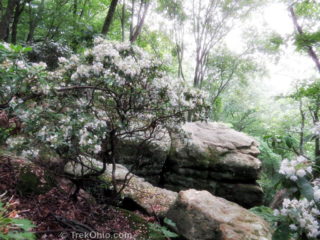 Mountain laurel is also known as calico bush or spoonwood. As a mature shrub this evergreen plant can grow to be anywhere between 9.8 feet to 29.5 feet in height (3 m to 9 m). It is native to the eastern United States, and it prefers to grow on rocky cliffs in acidic soil. Although it is a member of the blueberry family, no part of the plant is safe to eat. Even the pollen is poisonous which means that honey made from its pollen is also toxic. Besides being potentially lethal to humans, it is also Read more ➜
Mountain laurel is also known as calico bush or spoonwood. As a mature shrub this evergreen plant can grow to be anywhere between 9.8 feet to 29.5 feet in height (3 m to 9 m). It is native to the eastern United States, and it prefers to grow on rocky cliffs in acidic soil. Although it is a member of the blueberry family, no part of the plant is safe to eat. Even the pollen is poisonous which means that honey made from its pollen is also toxic. Besides being potentially lethal to humans, it is also Read more ➜ Mountain Laurel in Bloom at Shallenberger
 Mountain laurel is also known as calico bush or spoonwood. As a mature shrub this evergreen plant can grow to be anywhere between 9.8 feet to 29.5 feet in height (3 m to 9 m). It is native to the eastern United States, and it prefers to grow on rocky cliffs in acidic soil. Although it is a member of the blueberry family, no part of the plant is safe to eat. Even the pollen is poisonous which means that honey made from its pollen is also toxic. Besides being potentially lethal to humans, it is also Read more ➜
Mountain laurel is also known as calico bush or spoonwood. As a mature shrub this evergreen plant can grow to be anywhere between 9.8 feet to 29.5 feet in height (3 m to 9 m). It is native to the eastern United States, and it prefers to grow on rocky cliffs in acidic soil. Although it is a member of the blueberry family, no part of the plant is safe to eat. Even the pollen is poisonous which means that honey made from its pollen is also toxic. Besides being potentially lethal to humans, it is also Read more ➜ 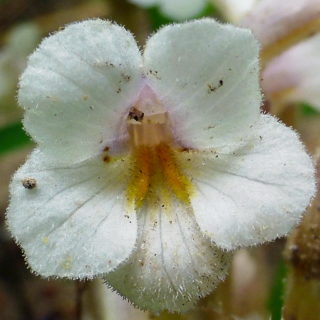 One-flowered broomrape (Orobanche uniflora) is also known as oneflowered broomrape, naked broomrape, cancer root, one-flowered cancer root, pipes, ghost pipes, squawdrops, and squirrel's grandfather. It is the fourth plant that we've dealt with here that has no chlorophyll. Without chlorophyll the plant is unable to nourish itself through photosynthesis, so it lives its life as a parasite, siphoning off its nourishment from other plants. Unlike the previous parasitic plants that we've discussed,
One-flowered broomrape (Orobanche uniflora) is also known as oneflowered broomrape, naked broomrape, cancer root, one-flowered cancer root, pipes, ghost pipes, squawdrops, and squirrel's grandfather. It is the fourth plant that we've dealt with here that has no chlorophyll. Without chlorophyll the plant is unable to nourish itself through photosynthesis, so it lives its life as a parasite, siphoning off its nourishment from other plants. Unlike the previous parasitic plants that we've discussed,  Bob and I have hiked many trails in the nature preserves and parks of Ohio. However the state of Ohio also has designated "State Wildlife Areas" that are under the management of the Ohio Department of Natural Resources. These are important areas for hunting and fishing in Ohio, but they aren't usually geared toward hiking and most of them lack trails. However some of these State Wildlife Areas do have trails, especially those that are good sites for birding.
In our last post I discussed a visit
Bob and I have hiked many trails in the nature preserves and parks of Ohio. However the state of Ohio also has designated "State Wildlife Areas" that are under the management of the Ohio Department of Natural Resources. These are important areas for hunting and fishing in Ohio, but they aren't usually geared toward hiking and most of them lack trails. However some of these State Wildlife Areas do have trails, especially those that are good sites for birding.
In our last post I discussed a visit 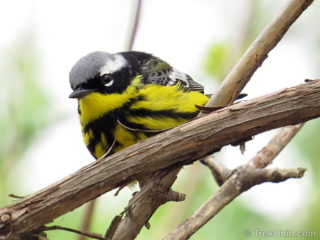 I am an aspiring birder; actually, I seem to be perpetually stuck at the "beginning birder" level. I enjoy and recognize the birds that frequent my backyard feeding station. And when hiking, I enjoy listening to birdsong and calls... but I rarely catch sight of those singing birds. Most of the time they seem to be perched high above me and hidden by the tree's foliage. However in Ohio there is an annual birding event called, The Biggest Week in American Birding, and this year I decided to give it
I am an aspiring birder; actually, I seem to be perpetually stuck at the "beginning birder" level. I enjoy and recognize the birds that frequent my backyard feeding station. And when hiking, I enjoy listening to birdsong and calls... but I rarely catch sight of those singing birds. Most of the time they seem to be perched high above me and hidden by the tree's foliage. However in Ohio there is an annual birding event called, The Biggest Week in American Birding, and this year I decided to give it 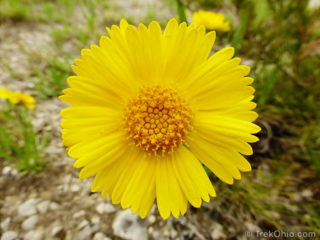 The Lakeside daisy is Ohio's rarest, native plant species. This plant only grows in four areas. Its largest population is in Ohio's Marblehead peninsula, part of Ottawa County. This is where the Lakeside Daisy State Nature Preserve is located. Lakeside daisies are also found in Michigan's upper peninsula, and in Ontario, Canada they can be found in the Bruce Peninsula and Manitoulin Island.
Lakeside daisies are the only representatives of their genus that live east of the Mississippi.
The Lakeside daisy is Ohio's rarest, native plant species. This plant only grows in four areas. Its largest population is in Ohio's Marblehead peninsula, part of Ottawa County. This is where the Lakeside Daisy State Nature Preserve is located. Lakeside daisies are also found in Michigan's upper peninsula, and in Ontario, Canada they can be found in the Bruce Peninsula and Manitoulin Island.
Lakeside daisies are the only representatives of their genus that live east of the Mississippi. 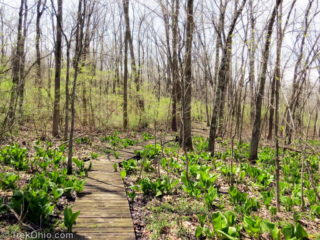 Fen habitats are America's most diverse habitat for vegetation, and many rare plants are found in fens. A fen is a type of wetland formed when water bubbles up from an underlying aquifer via an Artesian well or seep. In the case of Gallagher Fen, the water emerges from a hillside seep because two aquifers intersect nearby increasing the underground water pressure. Since the water is emerging from deep within the earth through limestone gravel dumped by glaciers during the last Ice Age, the water
Fen habitats are America's most diverse habitat for vegetation, and many rare plants are found in fens. A fen is a type of wetland formed when water bubbles up from an underlying aquifer via an Artesian well or seep. In the case of Gallagher Fen, the water emerges from a hillside seep because two aquifers intersect nearby increasing the underground water pressure. Since the water is emerging from deep within the earth through limestone gravel dumped by glaciers during the last Ice Age, the water 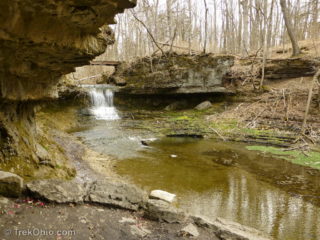 Glen Helen began when alumnus Hugh Taylor Birch donated a wooded glen to Antioch College in 1925 in memory of his daughter, Helen. The college continued to acquire adjacent land over the years, and the Glen Helen Nature Preserve now encompasses 1000 acres and 25 miles of hiking trails. The preserve is managed by the Glen Helen Ecology Institute. Within the preserve there is a yellow spring that has given its name to the town where the college and preserve are located. The preserve also includes limestone
Glen Helen began when alumnus Hugh Taylor Birch donated a wooded glen to Antioch College in 1925 in memory of his daughter, Helen. The college continued to acquire adjacent land over the years, and the Glen Helen Nature Preserve now encompasses 1000 acres and 25 miles of hiking trails. The preserve is managed by the Glen Helen Ecology Institute. Within the preserve there is a yellow spring that has given its name to the town where the college and preserve are located. The preserve also includes limestone 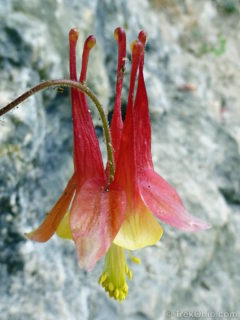 I was delighted at how many species of wildflower were in bloom at Fort Hill this past weekend. We saw many of the same flowers that appeared in April Wildflowers at Lake Katharine State Nature Preserve. So rather than posting duplicate flower photos, I'll just post ones that were newly seen at Fort Hill.
I was delighted at how many species of wildflower were in bloom at Fort Hill this past weekend. We saw many of the same flowers that appeared in April Wildflowers at Lake Katharine State Nature Preserve. So rather than posting duplicate flower photos, I'll just post ones that were newly seen at Fort Hill.
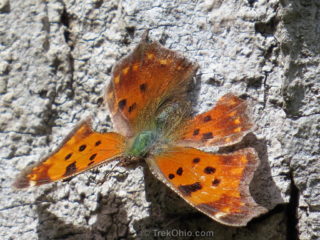 A short while ago I did a post on the Mourning Cloak butterfly. One of the odd things about this butterfly is that it looks like it only has four feet, but it actually has six feet like most insects. It's just that the front two are tiny, little things that the butterfly holds near its body. Someone thought the fuzzy, front feet looked like brushes, so that's how an entire family of butterfly species became known as the Brushfoot family. Today I'm going to look at two other species that are members
A short while ago I did a post on the Mourning Cloak butterfly. One of the odd things about this butterfly is that it looks like it only has four feet, but it actually has six feet like most insects. It's just that the front two are tiny, little things that the butterfly holds near its body. Someone thought the fuzzy, front feet looked like brushes, so that's how an entire family of butterfly species became known as the Brushfoot family. Today I'm going to look at two other species that are members 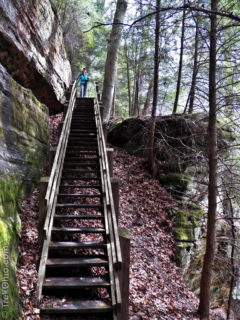 There are three trails at Lake Katharine. When we visited mid-April we hiked Salt Creek Trial and then Calico Bush Trail, but we didn't have time for the Pine Ridge Trail. The preserve struck us as being very scenic, and many spring flowers were in bloom during our visit. The Ohio Department of Natural Resources (ODNR) lists Lake Katharine as being one of the eight best preserves in the state for viewing spring wildflowers. The terrain is also interesting; it features many sandstone cliffs and outcroppings.
There are three trails at Lake Katharine. When we visited mid-April we hiked Salt Creek Trial and then Calico Bush Trail, but we didn't have time for the Pine Ridge Trail. The preserve struck us as being very scenic, and many spring flowers were in bloom during our visit. The Ohio Department of Natural Resources (ODNR) lists Lake Katharine as being one of the eight best preserves in the state for viewing spring wildflowers. The terrain is also interesting; it features many sandstone cliffs and outcroppings.